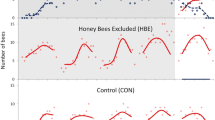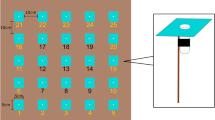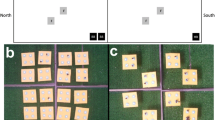Abstract
The relationship between actual and perceived profitability was investigated by quantifying choice behavior of foraging honey bees (Apis mellifera).Rate of net energy gain was used as a measure of profitability. Individual bees repeatedly chose between a yellow and a blue tubular artificial flower which had different associated profitabilities. Handling costs were manipulated by using flowers of different depth;energy gains were manipulated by using different volumes of a 20% (w/w) sucrose solution. Bees' discrimination between the two flowers increased as the absolute difference in profitabilities increased and discrimination decreased as profitabilities of both flowers increased. Therefore, discrimination depended on the relative difference in profitability between flowers, and therefore, perception was a nonlinear function of actual rates of net energy gain. The results also suggested that motivation to choose between flowers depended on the level of profitability. We suggest that nonlinear perceptual scales and motivation should be incorporated into models of food choice as constraints and should be considered in the design of experiments used to test predictions of models and in the interpretation of experimental results.
Similar content being viewed by others
References
Carterette, E. C., and Friedman, M. P. (1974).Handbook of Perception, Vol. 2, Academic Press, New York.
Elner, R. W., and Hughes, R. N. (1978). Energy maximization in the diet of the shore crab,Carcinus maenus.J. Anim. Ecol. 7: 103–116.
Heinrich, B. (1975). Energetics of pollination.Annu. Rev. Ecol. Syst. 6: 139–170.
Heinrich, B. (1979). “Majoring” and “minoring” by foraging bumblebees,Bombus vagans: An experimental analysis.Ecology 60: 245–255.
Heinrich, B. (1980). Mechanisms of body-temperature regulation in honeybees,Apis mellifera. II. Regulation of thoracic temperature at high air temperatures.J. Exp. Biol. 85: 73–87.
Hernstein, R. J., and van Sommers, P. (1962). Method for sensory scaling with animals.Science 135: 40–41.
Jones, F. N. (1974). Overview of psychophysical scaling methods. In Carterette, E. C., and Friedman, M. P. (eds.),Handbook of Perception, Vol. 2, Academic Press, New York, pp. 343–360.
Marden, J. H., and Waddington, K. D. (1981). Floral choices by honeybees in relation to the relative distances to flowers.Physiol. Entomol. 6: 431–435.
Stephens, D. W., and Krebs, J. R. (1986).Foraging Theory, Princeton University Press, Princeton, N.J.
Stephens, D. W., and Paton, S. R. (1986). How constant is the constant of risk-aversion?Anim. Behav. 34: 1659–1667.
Stevens, S. S. (1961). To honor Fechner and repeal his law.Science 133: 80–86.
Tversky, A., and Kahneman, D. (1981). The framing of decision and choice.Science 211: 453–458.
Waddington, K. D. (1985). Cost-intake information used in foraging.J. Insect Physol. 31: 891–897.
Waddington, K. D., and Holden, L. R. (1979). Optimal foraging: On flower selection by bees.Am. Nat. 114: 179–196.
Weast, R. C. (ed.) (1987).CRC Handbook of Chemistry and Physics, 68th ed., CRC Press, Inc., Boca Raton, FL
Author information
Authors and Affiliations
Rights and permissions
About this article
Cite this article
Waddington, K.D., Gottlieb, N. Actual vs perceived profitability: A study of floral choice of honey bees. J Insect Behav 3, 429–441 (1990). https://doi.org/10.1007/BF01052010
Accepted:
Issue Date:
DOI: https://doi.org/10.1007/BF01052010




